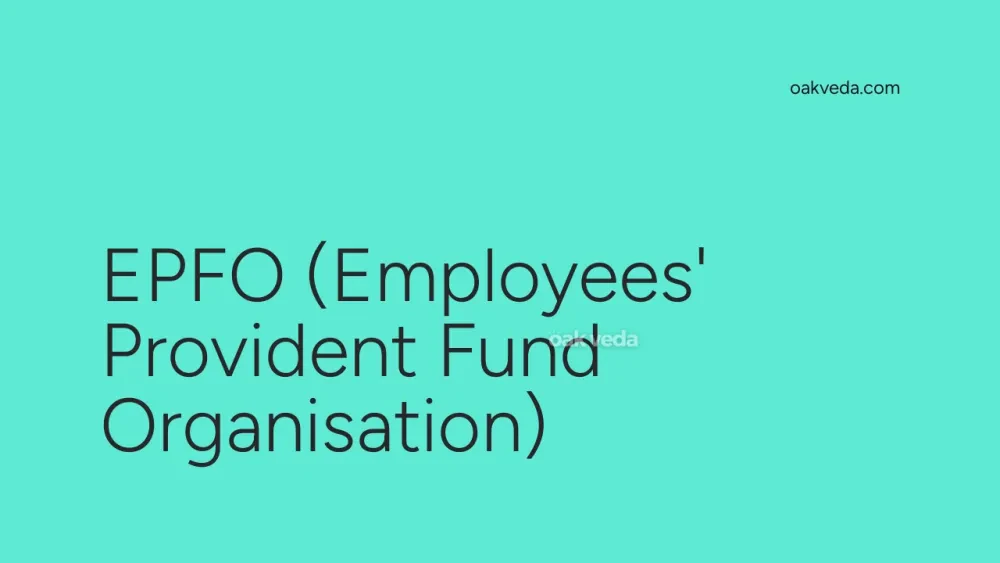
What is the Full Form of EPFO?
EPFO is the abbreviated form of Employees' Provident Fund Organisation. This statutory body plays a crucial role in India's social security system, serving millions of workers across the country.
What is Employees' Provident Fund Organisation?
The Employees' Provident Fund Organisation (EPFO) is a government organization in India that manages the Employees' Provident Fund (EPF) and related schemes. It operates under the Ministry of Labour and Employment and is responsible for administering various social security benefits for the Indian workforce.
Origin and Development of Employees' Provident Fund Organisation
The roots of EPFO can be traced back to 1951 when the Employees' Provident Fund Ordinance was first introduced. This ordinance was later replaced by the Employees' Provident Fund Act of 1952, which is now known as the Employees' Provident Funds & Miscellaneous Provisions Act, 1952.
Since its inception, EPFO has grown to become one of India's largest social security organizations. It has expanded its reach and services over the years, adapting to the changing needs of the workforce and the economy.
How does Employees' Provident Fund Organisation work?
EPFO operates through a network of offices spread across India. The organization is structured as follows:
- Zonal offices headed by Additional Central Provident Fund Commissioners
- Regional offices led by Regional Provident Fund Commissioners, Grade I
- Sub-regional offices managed by Regional Provident Fund Commissioners, Grade II
- District offices with Compliance Officers for local monitoring and complaint resolution
This hierarchical structure ensures efficient management and service delivery across the country.
Functions of Employees' Provident Fund Organisation
EPFO performs several critical functions to support India's workforce:
- Provident Fund Management: Administers the mandatory provident fund contribution program for eligible employees.
- Pension Scheme Administration: Manages the Employees' Pension Scheme.
- Insurance Coverage: Oversees the Employees' Deposit Linked Insurance Scheme.
- International Cooperation: Acts as a nodal agency for implementing Bilateral Social Security Agreements with other countries.
- Grievance Redressal: Provides a platform for addressing employee and employer grievances related to EPF services.
Applications of Employees' Provident Fund Organisation
EPFO's services cater to both employees and employers:
For Employees:
- UAN (Universal Account Number) member e-Sewa
- Online UAN status checking
- Grievance management system
- Online transfer claim portal
- Pension fund platform
- Inoperative accounts help desk
For Employers:
- Online establishment registration
- UAN information provision
- EPF subscription payment
- Online challan and ECR submission
- Grievance management system
- Online transfer claim portal
Features of Employees' Provident Fund Organisation
- Nationwide Coverage: EPFO operates across India, excluding Jammu and Kashmir.
- Digital Services: Offers a range of online services for convenience and efficiency.
- Mandatory Participation: Ensures widespread social security coverage for eligible employees.
- Interest Accrual: Provides interest on EPF contributions, helping employees grow their savings.
- Tax Benefits: EPF contributions and interest are eligible for tax deductions under Indian tax laws.
Benefits of Employees' Provident Fund Organisation
- Financial Security: Helps employees save for retirement and unforeseen circumstances.
- Pension Provision: Offers pension benefits to eligible members and their families.
- Insurance Coverage: Provides life insurance benefits through the EDLI scheme.
- Employer Contribution: Employees benefit from additional contributions made by their employers.
- Portability: Allows transfer of EPF accounts when changing jobs, ensuring continuity of benefits.
Limitations or Challenges of Employees' Provident Fund Organisation
- Coverage Limitations: Not all workers in the unorganized sector are covered under EPFO schemes.
- Withdrawal Restrictions: Strict rules govern when and how much can be withdrawn from EPF accounts.
- Administrative Delays: Processing of claims and transfers can sometimes face delays.
- Digital Divide: Some workers may face difficulties accessing online services due to lack of digital literacy.
- Compliance Issues: Ensuring all eligible employers register and contribute to EPF can be challenging.
Future Developments in Employees' Provident Fund Organisation Technology
EPFO is continuously evolving to improve its services:
- AI Integration: Exploring artificial intelligence for faster claim processing and fraud detection.
- Mobile Apps: Developing user-friendly mobile applications for easier access to EPFO services.
- Blockchain Technology: Considering blockchain for secure and transparent record-keeping.
- Data Analytics: Utilizing big data analytics for better decision-making and policy formulation.
- Universal Social Security: Working towards extending coverage to a larger section of the workforce.
FAQs on EPFO Full Form
-
What is the full form of EPFO? The full form of EPFO is Employees' Provident Fund Organisation.
-
When was EPFO established? EPFO was established in 1952 under the Employees' Provident Funds & Miscellaneous Provisions Act.
-
Who is eligible for EPF? Generally, employees earning up to ₹15,000 per month in organizations with 20 or more workers are eligible for EPF.
-
Can I check my EPF balance online? Yes, you can check your EPF balance online through the EPFO member portal using your UAN.
-
What is UAN in EPFO? UAN stands for Universal Account Number, a unique 12-digit number assigned to each EPF member for easy account management.
In conclusion, the Employees' Provident Fund Organisation (EPFO) plays a vital role in India's social security framework. By understanding its full form, functions, and benefits, employees and employers can better utilize the services offered by this crucial organization. As EPFO continues to evolve and embrace new technologies, it aims to provide even more efficient and accessible social security services to India's workforce.
You may be interested in:
- IATA (International Air Transport Association)
- OTP (One Time Password): Full Form and Explanation
- pH (Potential of Hydrogen): Full Form and Explanation
- CST (Central Sales Tax): Full Form and Explanation
- DNS (Domain Name System): Full Form and Explained
- CFO (Chief Financial Officer): Full Form and Role

